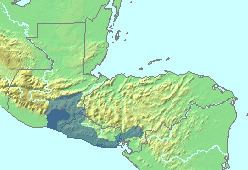Ethnicity Xinca people ISO 639-3 xin | Glottolog xinc1237 | |
 | ||
Subdivisions YupiltepequeJumaytepequeChiquimulillaGuazacapánSinacantán | ||
Xinca (Szinca) is a small family of Mesoamerican languages, now nearly extinct, once spoken by the indigenous Xinca people in southeastern Guatemala, much of El Salvador, and bits of Honduras.
Contents
Classification
The Xincan languages have no demonstrated affiliations with other language families. Lehmann (1920) tried linking Xincan with Lencan, but the proposal was never demonstrated.
Languages
There were at least four Xincan languages, all of which are now either moribund or extinct (Campbell 1997:166). Yupiltepeque was spoken in Jutiapa Department, while the rest are spoken in Santa Rosa Department. Campbell also suggests that the Alagüilac language of San Cristóbal Acasaguastlán may have in fact been a Xincan language.
To these, Glottolog adds
Sachse (2010) considers all Xincan speakers today to be semi-speakers, with the completely fluent speakers having already died.
History
Xincan languages have many loanwords from Mayan languages especially in agricultural terms, suggesting extensive contact with Mayan peoples.
In the 16th century the territory of the Xinca extended from the Pacific coast to the mountains of Jalapa. In 1524 the population was conquered by the Spanish Empire. Many of the people were forced into slavery and compelled to participate in the conquest of modern-day El Salvador. It is from this that the names for the town, river, and bridge "Los Esclavos" (The Slaves) are derived in the area of Cuilapa, Santa Rosa.
After 1575, the process of Xinca cultural extinction accelerated, mainly due to their exportation to other regions. This also contributed to a decrease in the number of Xinca-language speakers. One of the oldest references concerning this language was presented by the archbishop Pedro Cortés y Larraz during a visit to the diocese of Taxisco in 1769.
Historical distribution
Xincan languages were once more widespread, which is evident in various toponyms with Xincan origins (Campbell 1997:166). These toponyms are marked by such locative prefixes as ay- "place of" (e.g. Ayampuc, Ayarza), al- "place of" (Alzatate), san- "in" (e.g. Sansare, Sansur), or with the locative suffixes -(a)gua or -hua "town, dwelling" (e.g. Pasasagua, Jagua, Anchagua, Xagua, Eraxagua).
Kaufman (1970:66) lists the following towns as once being Xinca-speaking.
Sachse (2010), citing colonial-era sources, lists the following villages in Santa Rosa Department and Jutiapa Department as having Xinca speakers during the Spanish colonial era.
Contemporary situation
Presently Xinca, one of the very few known indigenous languages of Guatemala not believed to be part of the family of Mayan languages, has nearly disappeared. According to recent studies, it is spoken in seven municipalities and a village in Santa Rosa and Jutiapa. In 1991 it was reported that the language had only 25 speakers, and the 2006 edition of the Encyclopedia of Language and Linguistics reported fewer than ten. Nonetheless, of the 16,214 Xinca who responded to the 2002 census, 1,283 reported being Xinka speakers.
